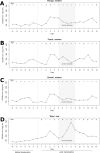Environmental stressors may cause equine herpesvirus reactivation in captive Grévy's zebras (Equus grevyi)
- PMID: 30155350
- PMCID: PMC6109370
- DOI: 10.7717/peerj.5422
Environmental stressors may cause equine herpesvirus reactivation in captive Grévy's zebras (Equus grevyi)
Abstract
Equine Herpesviruses (EHV) are common and often latent pathogens of equids which can cause fatalities when transmitted to non-equids. Stress and elevated glucocorticoids have been associated with EHV reactivation in domestic horses, but little is known about the correlation between stress and viral reactivation in wild equids. We investigated the effect of an environmental stressor (social group restructuring following a translocation event) on EHV reactivation in captive Grévy's zebras (Equus grevyi). A mare was translocated by road transport from Zoo Mulhouse, France, to join a resident group of three mares in Tierpark Berlin, Germany. We used an indirect sampling method to assess the frequency of EHV shedding for 14 days immediately after the translocation event (termed the 'experimental period'). The results were compared with those from two control periods, one preceding and one subsequent to the experimental period. In addition, we measured fecal glucocorticoid metabolite (fGCM) concentrations daily in all individuals from 6 days before, to 14 days after translocation. We found significantly higher EHV shedding frequencies during the experimental period, compared to each of the two control periods. All animals showed significantly elevated fGCM concentrations, compared to fGCM levels before translocation. Finally, we found that an increase in fGCM concentration was significantly associated with an increased likelihood of EHV shedding. Although the small number of animals in the study limits the conclusions that can be drawn from the study, taken together, our results support the hypothesis that environmental stressors induce viral reactivation in wild equids. Our results suggest that potentials stressors such as group restructuring and translocation should be considered in the management of zoological collections to reduce the risk of fatal EHV infections in novel hosts. Moreover, environmental stressors may play an important role in EHV reactivation and spread in wild equid populations.
Keywords: EHV; Fecal glucocorticoids; Latent infection; Reactivation.
Conflict of interest statement
The authors declare there are no competing interests.
Figures





Similar articles
-
Noninvasive Detection of Equid Herpesviruses in Fecal Samples.Appl Environ Microbiol. 2019 Jan 23;85(3):e02234-18. doi: 10.1128/AEM.02234-18. Print 2019 Feb 1. Appl Environ Microbiol. 2019. PMID: 30446563 Free PMC article.
-
Environmental Detection and Potential Transmission of Equine Herpesviruses.Pathogens. 2021 Apr 1;10(4):423. doi: 10.3390/pathogens10040423. Pathogens. 2021. PMID: 33916280 Free PMC article. Review.
-
Seroprevalence of Equine Herpesviruses 1 and 9 (EHV-1 and EHV-9) in Wild Grévy's Zebra ( Equus grevyi) in Kenya.J Wildl Dis. 2018 Oct;54(4):848-851. doi: 10.7589/2018-01-003. Epub 2018 May 24. J Wildl Dis. 2018. PMID: 29792760
-
A SEROLOGIC AND POLYMERASE CHAIN REACTION SURVEY OF EQUINE HERPESVIRUS IN BURCHELL'S ZEBRAS (EQUUS QUAGGA), HARTMANN'S MOUNTAIN ZEBRAS (EQUUS ZEBRA HARTMANNAE), AND THOMSON'S GAZELLES (EUDORCAS THOMSONII) IN A MIXED SPECIES SAVANNAH EXHIBIT.J Zoo Wildl Med. 2016 Dec;47(4):1013-1018. doi: 10.1638/2013-0297.1. J Zoo Wildl Med. 2016. PMID: 28080902
-
Equine herpesviruses type 1 (EHV-1) and 4 (EHV-4)--masters of co-evolution and a constant threat to equids and beyond.Vet Microbiol. 2013 Nov 29;167(1-2):123-34. doi: 10.1016/j.vetmic.2013.06.018. Epub 2013 Jul 6. Vet Microbiol. 2013. PMID: 23890672 Review.
Cited by
-
Noninvasive Detection of Equid Herpesviruses in Fecal Samples.Appl Environ Microbiol. 2019 Jan 23;85(3):e02234-18. doi: 10.1128/AEM.02234-18. Print 2019 Feb 1. Appl Environ Microbiol. 2019. PMID: 30446563 Free PMC article.
-
A Pilot Serosurvey for Selected Pathogens in Feral Donkeys (Equus asinus).Animals (Basel). 2020 Oct 2;10(10):1796. doi: 10.3390/ani10101796. Animals (Basel). 2020. PMID: 33023217 Free PMC article.
-
Environmental Detection and Potential Transmission of Equine Herpesviruses.Pathogens. 2021 Apr 1;10(4):423. doi: 10.3390/pathogens10040423. Pathogens. 2021. PMID: 33916280 Free PMC article. Review.
-
Stress-Related Herpesvirus Reactivation in Badgers Can Result in Clostridium Proliferation.Ecohealth. 2021 Dec;18(4):440-450. doi: 10.1007/s10393-021-01568-2. Epub 2021 Dec 6. Ecohealth. 2021. PMID: 34870778 Free PMC article.
-
Serological Examinations of Significant Viral Infections in Domestic Donkeys at the Special Nature Reserve "Zasavica", Serbia.Animals (Basel). 2023 Jun 21;13(13):2056. doi: 10.3390/ani13132056. Animals (Basel). 2023. PMID: 37443854 Free PMC article.
References
-
- Baker L, Lawrence MS, Toews M, Kuling S, Fraser D. Personality differences in a translocated population of endangered kangaroo rats (Dipodomys stephensi) and implications for conservation success. Behaviour. 2016;153:1795–1816. doi: 10.1163/1568539X-00003380. - DOI
LinkOut - more resources
Full Text Sources
Other Literature Sources

